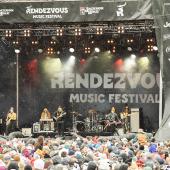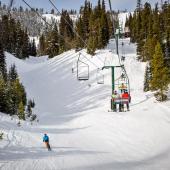The Pinhead Classic
Creative costumery, copious cross-dressing, amazing music, parades, parties, prizes, and pandemonium—it’s not New Orleans, it’s Mardi Gras in Montana: the Montana Telemark Corporation’s Pinhead Classic, affectionately referred to by freeheel fanatics everywhere as “the Pinhead.” Every spring, impassioned pinheads from across the country come to Bridger Bowl to celebrate in the most unique ski event in the known universe.
Describing the Pinhead as a telemark ski race is like calling The Rocky Horror Picture Show a movie; it completely misses the point of what these phenomena have become. The Pinhead did start life as a sanctioned telemark ski race on the national circuit, with serious racers competing for the fastest time. And the Pinhead still has some of its racing roots. It’s set up as a dual slalom where two racers “compete” against each other in a head-to-head format. Or, it’s at least theoretically possible that this would happen. But over time the Pinhead has morphed into something very different.
If you were to attend a recent Pinhead event, you would see a horde of tele-skiers in outrageous costumes socializing, taking pictures of each other, partying, and generally egging each other on. If you watched the so-called race course for any period of time, you would see a variety of performances.
Some contestants use the course as a stage, acting out their chosen Pinhead roles. One year, under the theme of Viva Las Vegas, two white tiger pinheads jumped through the flaming hoops of noted telemark skiers Siegfried and Roy. Another year, when The Wizard of Oz was the theme, flying monkeys on skis chased down a tele-skiing scarecrow.
Other contestants use the course to show off their skiing and jumping abilities, deftly negotiating the course’s many obstacles and launching themselves into the stratosphere off sizeable, well-built jumps, hoping to win the coveted Eddie the Eagle award for biggest air. Or, if they fail at achieving the biggest air, perhaps they’ll get the consolation award for best crash. Prizes are also given for the best costumes, the best cross-dressing, youngest and oldest pinheads, and anything noteworthy that occurs during the event. About the only thing you can’t win a prize for is fastest time.
The party atmosphere is enhanced by music, goodwill, and acceptance—diehard pinheads who have been participating in the Pinhead for over 20 years mingle merrily with skiers and snowboarders donning tele-gear for the first time. To participate in the Pinhead Classic, tele-skiing ability is optional, but having a good time is mandatory.
This year marks the Pinhead’s 25th consecutive year, making it the oldest continuously-run amateur event at Bridger Bowl. How the Pinhead went from being a serious telemark ski race to a freeheel festival of pageantry for pinheads is a story of serendipity and social engineering.
“Nobody really planned the Pinhead as it exists today,” says Warren Bauder, current president of The Montana Telemark Corporation. “It just evolved over the years.” The history of the Pinhead suggests that this is true, but it’s also true that the efforts and creativity of a number of people helped turn the Pinhead into what it has become. Over the years, management of the festival has been handed down from one set of dedicated volunteers to another, with each group not only keeping the Pinhead a vital event, but also allowing it to evolve.
The first big influence happened in 1982, the Pinhead’s second year, when the event was sponsored by Jose Cuervo tequila. Shots of tequila were given to the racers in the starting gate, to “settle the butterflies.” The association with Jose Cuervo also provided a handy excuse for an after-race party. This became an instant tradition, with beers, bands, and bawdiness being an important part of every Pinhead event. Ever since, a party atmosphere has predominated at the Pinhead, both on and off the slopes.
Another incident in the early years was when Whitney Thurlow, a local tele-racer who also happened to be the North American telemark champion for a number of years, showed up in a wig. The following year, Roger Stoltzfuss, Noah Poritz, and a few other racers involved with the organizing the event, donned outlandish attire. This started a tradition of costumery which slowly evolved until it became the hallmark of the race. The 5th Pinhead, under Roger and Noah’s direction, offered prizes for the best costumes.
Another tradition that developed in the early ‘80s was that of “getting air time” (or “hucking,” as it’s known by the new-schoolers). Onlookers each year line up at the course’s biggest jump, cheering for contestants to get big air (and sometimes booing those who chicken out and ski around the jumps). Along the way there are plenty of good crashes, with both categories offering quality prizes. The big air and best crash tradition was cemented by Mark Prince, who unknowingly invented powder skis over a decade before the ski companies. Mark made a pair of ultra-wide skis by sawing his skis down the middle on a band saw and inserting wood planks between the halves. He donned these primitive fatties for his costume of Eddie the Eagle, the infamous ski jumper from England who finished last in the 1988 Calgary Olympics. Everyone thought that Mark’s bumbling on skis that year was acting out his costume. Mark, however, proclaimed the experimental boards unskiable and created the Eddie the Eagle trophies for the biggest air and best crash. “Airs” apparent across the telemark universe now covet these trophies.
Mark was also responsible for the Montana Telemark Corporation becoming a non-profit organization. Over the years, in addition to putting on the Pinhead, the MTC has hosted free learn-to-telemark events, removed 20 tons of garbage from the Gallatin River in a “Recycle the River” event, and raised funds for the Friends of the Gallatin National Forest Avalanche Center.
During Mark’s tenure on the board, awards for fastest time—the normal benchmark of any ski-racing event—were abandoned, and eventually the timing system for the race also went the way of the dinosaurs. This happened by a voice vote at a Pinhead party and ended any pretense that the Pinhead was a true race.
In the early 1990s, Lisa and Russ Tuckerman brought new energy to the MTC Board. Russ, who had great connections in the outdoor industry, put his energy into soliciting prizes from sponsors. In true Pinhead homegrown fashion, he attended the Outdoor Retailer Trade Show with elk sausage and homemade beer. His efforts garnered prizes galore, and for a period of time it was a given that everyone who entered the Pinhead would win a prize.
Russ also traveled internationally to telemark events and observed how Europeans integrated obstacles into their ski courses. Banked corners, bicycle bumps, whoop-de-dos, and other snow-sculpted features have now become an essential part of skiing in the Pinhead.
The final demarcation in the evolution of the Pinhead as it currently exists was Jerry Garcia’s death. That year the Pinhead event was set up as a Jerry Garcia Memorial. Numerous Jerrys showed up, along with a host of other musicians. The attire the skiers wore was so inspired that various themes have been used ever since.
Themes have become the heart and soul of the Pinhead. The dedicated volunteers of the Montana Telemark Corporation carefully choose the Pinhead theme each year to elicit the most outrageous costumes and behavior possible. In recent years themes have included “superheroes and villains,” “Medievel Knievel,” “Never Never Land,” “Dr. Seuss,” “High Crimes and Misdemeanors,” and “The Wizard of Oz.” A perennial favorite in the costume department is cross-dressing. For instance, last year there were plenty of Wonder Women, many of whom where males busting out of their wonder-bras. The costumes sometimes have lasting effects. For years after the “Wizard of Oz” Pinhead, former tele-Dorothys were seen sporting tele-boots with leftover red glitter.
This year’s Pinhead theme is fitting for its 25th year: The Pinhead Reunion. When asked about some of their best memories from Pinhead’s past, previous organizers mostly laugh. “Nothing you’d want to print,” exclaims Roger Stoltzfuss. One memory everyone is willing to talk about is the year it snowed 50 inches in the 48 hours prior to the Pinhead. Organizers quickly gave up working on the course to go powder skiing. Despite the fact that there was no course, the Pinhead occurred, with over 100 skiers participating and skiing fabulous powder in their costumes.
Obviously there is plenty more to learn about Pinheads past, and this year’s theme is sure to bring out old tele-skiers, some old favorite costumes, and perhaps some tele-tall-tales. If you’ve been in a Pinhead before, be sure to come and relive some of your past tele-heritage. If you’ve never attended a Pinhead, it’s never too late to become part of a tradition that now spans generations.










